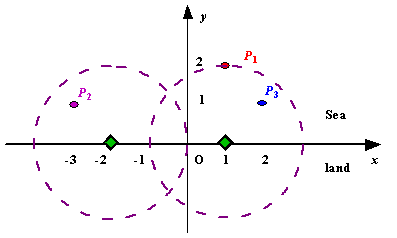Radar Installation
Description
Assume the coasting is an infinite straight line. Land is in one side of coasting, sea in the other. Each small island is a point locating in the sea side. And any radar installation, locating on the coasting, can only cover d distance, so an island in the sea can be covered by a radius installation, if the distance between them is at most d.
We use Cartesian coordinate system, defining the coasting is the x-axis. The sea side is above x-axis, and the land side below. Given the position of each island in the sea, and given the distance of the coverage of the radar installation, your task is to write a program to find the minimal number of radar installations to cover all the islands. Note that the position of an island is represented by its x-y coordinates.

Figure A Sample Input of Radar Installations
We use Cartesian coordinate system, defining the coasting is the x-axis. The sea side is above x-axis, and the land side below. Given the position of each island in the sea, and given the distance of the coverage of the radar installation, your task is to write a program to find the minimal number of radar installations to cover all the islands. Note that the position of an island is represented by its x-y coordinates.

Figure A Sample Input of Radar Installations
Input
The input consists of several test cases. The first line of each case contains two integers n (1<=n<=1000) and d, where n is the number of islands in the sea and d is the distance of coverage of the radar installation. This is followed by n lines each containing two integers representing the coordinate of the position of each island. Then a blank line follows to separate the cases.
The input is terminated by a line containing pair of zeros
The input is terminated by a line containing pair of zeros
Output
For each test case output one line consisting of the test case number followed by the minimal number of radar installations needed. "-1" installation means no solution for that case.
Sample Input
3 2 1 2 -3 1 2 1 1 2 0 2 0 0
Sample Output
Case 1: 2 Case 2: 1
代码如下:
#include<iostream>
#include<math.h>
#include<algorithm>
using namespace std;
struct node
{
double l,r;
} a[1111];
bool cmp(node a,node b)
{
return a.l<b.l;
}
int main()
{
int n,i,j,flag,sum=0;
double d,x,y;
while(cin>>n>>d&&n&&d)
{
sum++;
flag=1;
for(i=0; i<n; i++)
{
cin>>x>>y;
if(y>d)
{
flag=-1;
}
a[i].l=x-sqrt(d*d-y*y);
a[i].r=x+sqrt(d*d-y*y);
}
if(flag==-1)
{
cout<<"Case "<<sum<<": "<<flag<<endl;
continue;
}
sort(a,a+n,cmp);
for(i=1;i<n;i++)
if(a[i-1].r>=a[i].l)
{
a[i].l=max(a[i].l,a[i-1].l);
a[i].r=min(a[i].r,a[i-1].r);
}
else flag++;
cout<<"Case "<<sum<<": "<<flag<<endl;
}
return 0;
}




 本文介绍了一个基于坐标系的算法,用于解决如何用最少数量的雷达安装来覆盖海面上多个岛屿的问题。通过输入岛屿的位置和雷达的覆盖范围,该算法能够找到最小数量的雷达安装方案。
本文介绍了一个基于坐标系的算法,用于解决如何用最少数量的雷达安装来覆盖海面上多个岛屿的问题。通过输入岛屿的位置和雷达的覆盖范围,该算法能够找到最小数量的雷达安装方案。
















 1157
1157

 被折叠的 条评论
为什么被折叠?
被折叠的 条评论
为什么被折叠?








